The vibrant colors of many Russula species make them a common mushroom to show up in ID groups and forums. Russula mushrooms are also prevalent across the country, and their likelihood to show up in great quantity is very noticeable and appealing. They look great, and there are lots of them – please let them all be edible! However, as much as it would be nice to give short and quick identifications, the Russula genus is a complicated and messy place.
Most North American foragers bypass these mushrooms, not caring to bother with them due to their often poor quality compared to other, more valued wild mushrooms. The uncommonness of foraging in this country, though, is not an indication of their edibility.
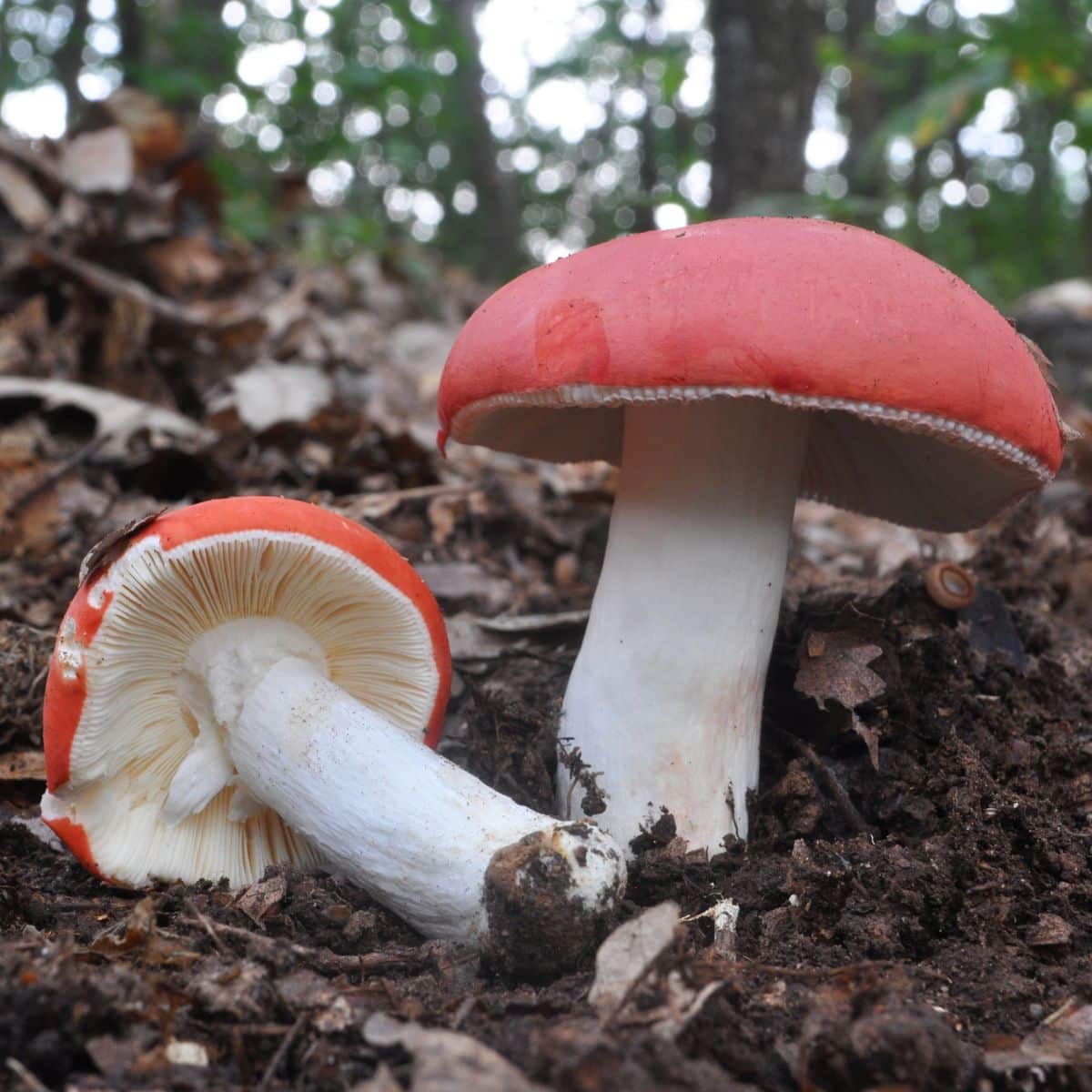
These mushrooms are widely foraged species around the world. Primarily, this is due to their abundance, which makes them appealing as a food source even if they aren’t the finest tasting. Regional knowledge passed down through centuries as to which ones are good for eating is crucial to our current understanding of which species are worth collecting. And how to identify them properly.
This comprehensive guide will explore a few prime species of Russula mushrooms found in the United States, their identification characteristics, habitat, edibility, and more. We’ll also cover some basic features that these mushrooms possess, so you can at least identify the genus while out in the woods.
- Scientific Name: Russula sp.
- Common Names: Brittle gills
- Habitat: Varies but always on the ground
- Edibility: Varies
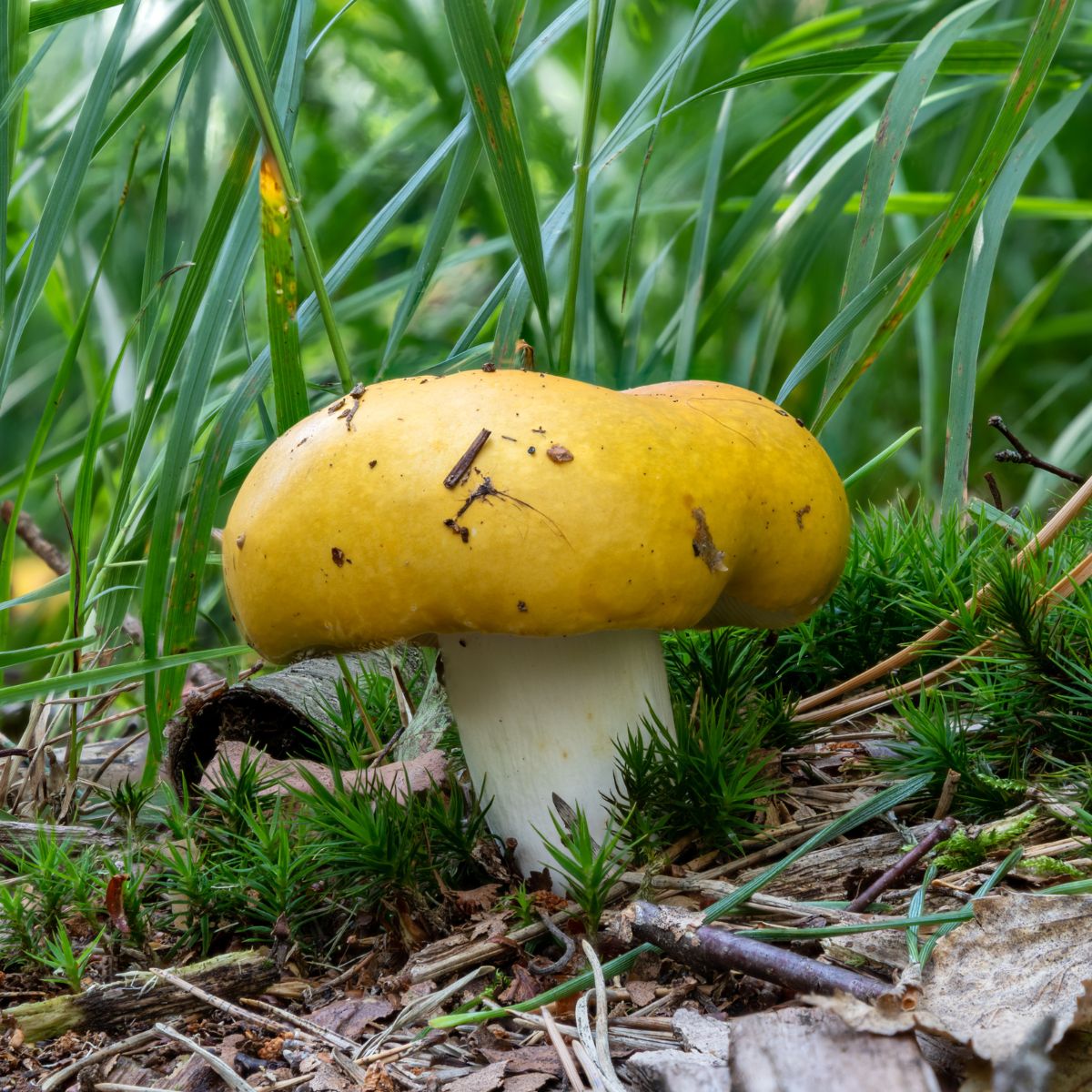
Jump to:
The Russula Genus: A Brief Overview
Russula is a large and diverse genus of ectomycorrhizal mushrooms with approximately 700 species worldwide. These mushrooms are known for their striking colors, typically ranging from bright reds and oranges to yellows and browns. Their distinguishing characteristics include (often) brightly colored caps, attached and brittle gills, absence of latex, and absence of partial veil or volva tissue on the stem.
In the past, they were often referred to as “brittle gills” due to the fragile nature of their gills. The genus Russula was officially described by Christian Hendrik Persoon in 1796, who recognized their fleshy fruit bodies, depressed caps, and equal gills as defining characteristics.
Russula mushrooms exhibit a wide range of edibility, with some species considered choice edibles, while others are known to be inedible or even toxic. If you are interested in foraging and consuming Russula mushrooms, it is essential to exercise caution.


How to Recognize Russula Mushrooms
This guide covers most of the primary features of Russula species. Of course, it is not extensive, and not every species of this genus falls into place exactly. However, most species do follow these general guidelines. Included is a lot of what it doesn’t look like, as that is also a fundamental way to identify these species. What are they missing compared to other easier-to-identify genera?
Season
Varies widely by species
Habitat
Russula mushrooms inhabit a variety of ecosystems, including both deciduous and coniferous forests. They form mycorrhizal associations with trees, benefiting both the fungus and the host plant. Russula mushrooms can be found in moist and dry habitats depending on the species.
Russulas grow from the ground, never from wood or trees. They appear singularly or in scattered or dense groupings. Sometimes, they grow in clumps or overlapping but each specimen will have it’s own stem.
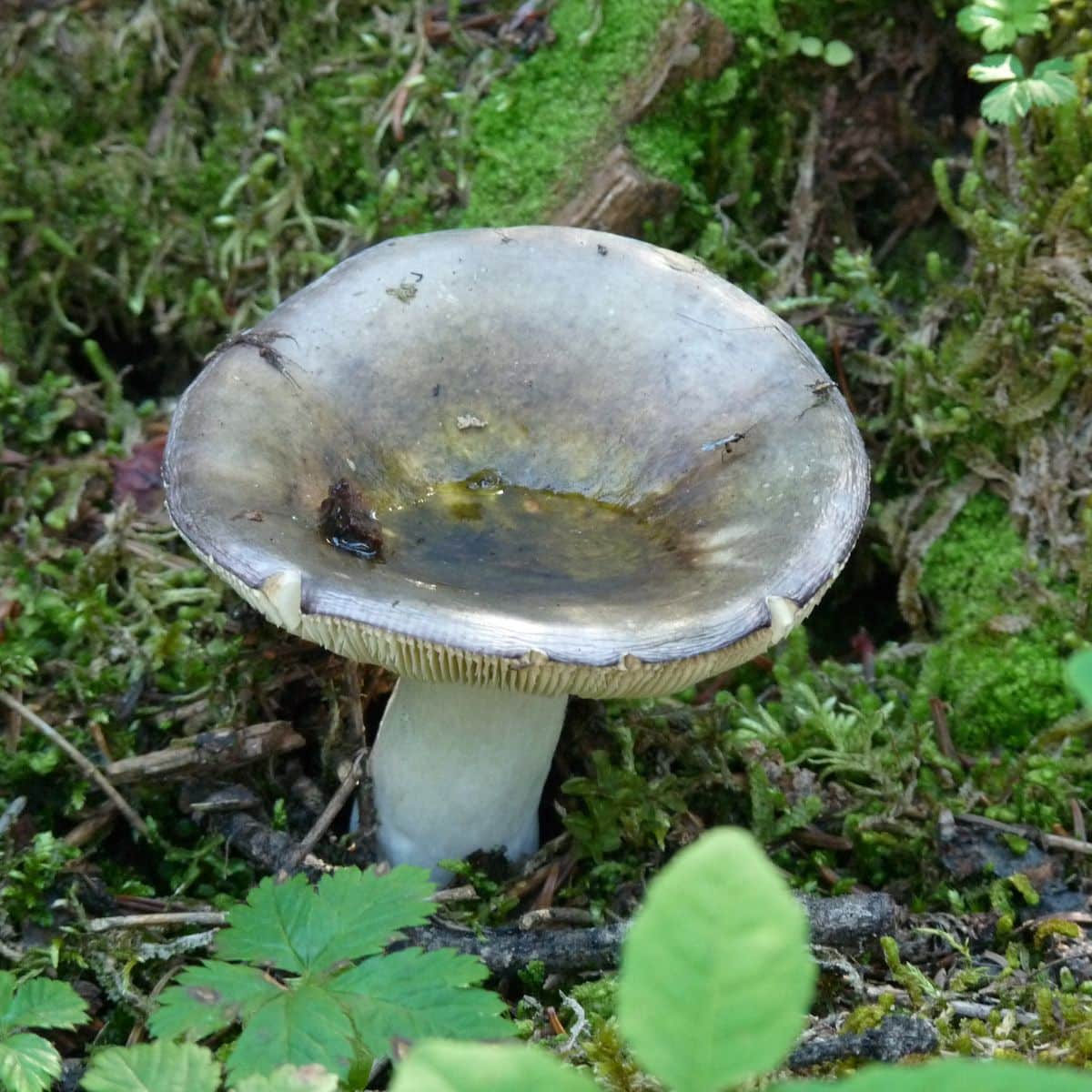
Cap
Russula mushrooms have caps that start out convex (rounded). As they mature, the caps open up and flatten out. At full to past maturity, the cap edges may flare upwards, like wings, and show off their gills.
The cap diameter ranges from as small as 1 inch to as large as 6 inches or more. Colors can be incredibly diverse, including shades of red, orange, yellow, and brown. Some species may also exhibit color variations within a single collection. And some change color over time, going from brightly colored to washed out and generally lackluster looking.
Russula mushrooms feature a distinct skin called a cuticle over the cap, which can be peeled off. The amount or degree to which the skin can be peeled is a crucial part of identification. With some species, you can peel the entire cuticle off, while with others, you can only peel a bit around the cap edges.
The cap edge is striated, which means it has vertical groves all along it. These groves may be faint or very clear. This striation matches the spacing of the gills below it.
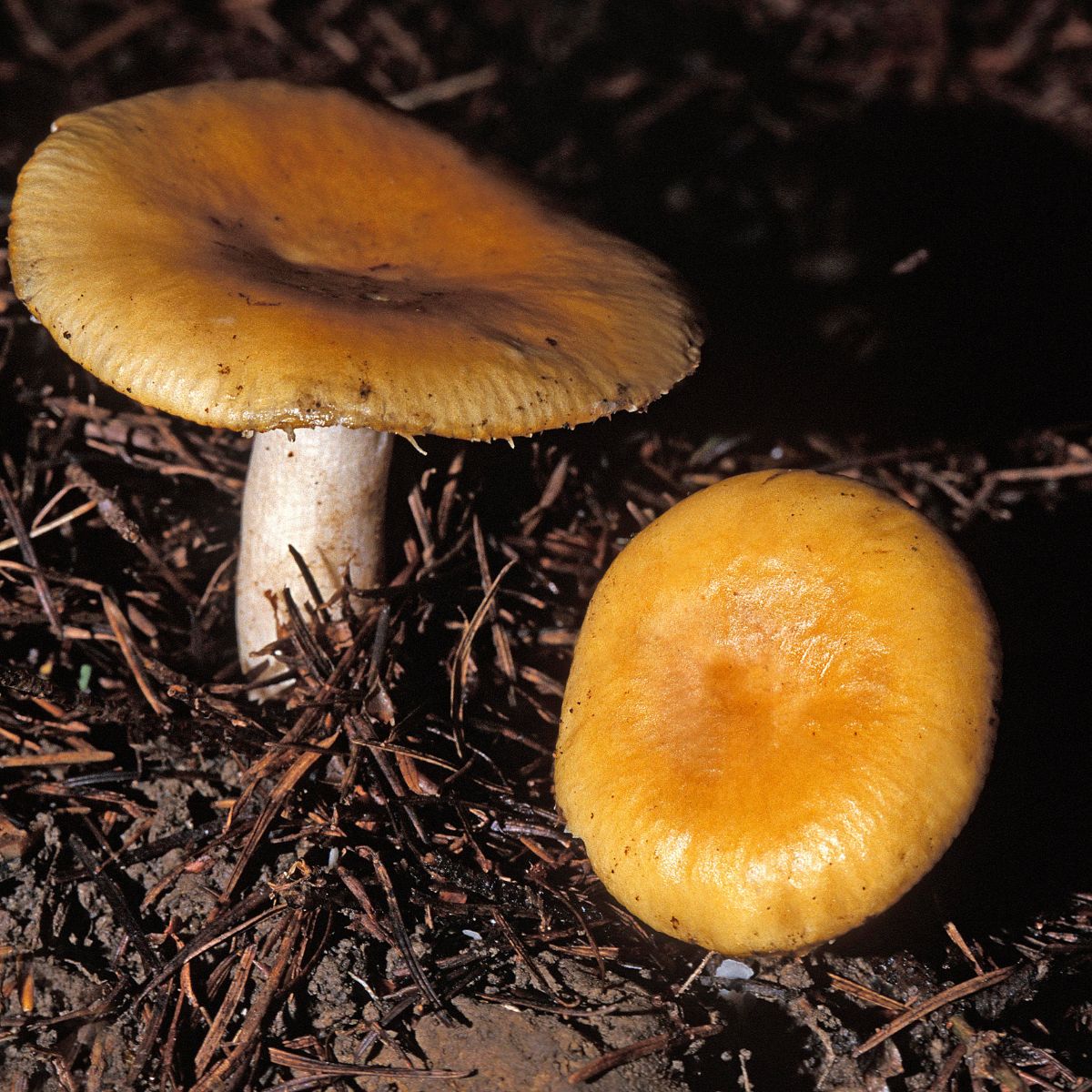
Gills
All Russula mushrooms have gills, and they are typically brittle. This is how it earned its common name, “brittle gill.” In most cases, the gills are attached to the stem, but this does vary a bit as to how. Some are almost decurrent (running down the stem), while others are almost free (not attached at all).
Unlike some related genera, such as Lactarius (Milky caps), Russula mushrooms do not exude a milky substance when the gills are broken.

Stem
The stems of Russula mushrooms are usually solid, cylindrical and can vary in length. They are usually short and stubby, though, no longer than the width of the cap. Colors can range from white to pale yellow or even reddish-brown but are most often white or off-white. With age, the stems may become hollow.
When you break the stem in half, it snaps easily and often audibly – another example of its brittle flesh. Many other mushroom species do not have stems that snap so simply and cleanly. The inside of the stem might look mushy or at least not firm — this happens from bug damage and with age



Smell and Taste
Many Russula species have distinctive smells. Some may have an almond scent, while others may emit a stinky or fishy odor. This is a good way to identify some of the nice edible species, by smelling them since it will set them apart from other similar Russula.
Doing a quick nibble and spit taste test is also super important with these species. Some are super bitter, while others are undistinctive.
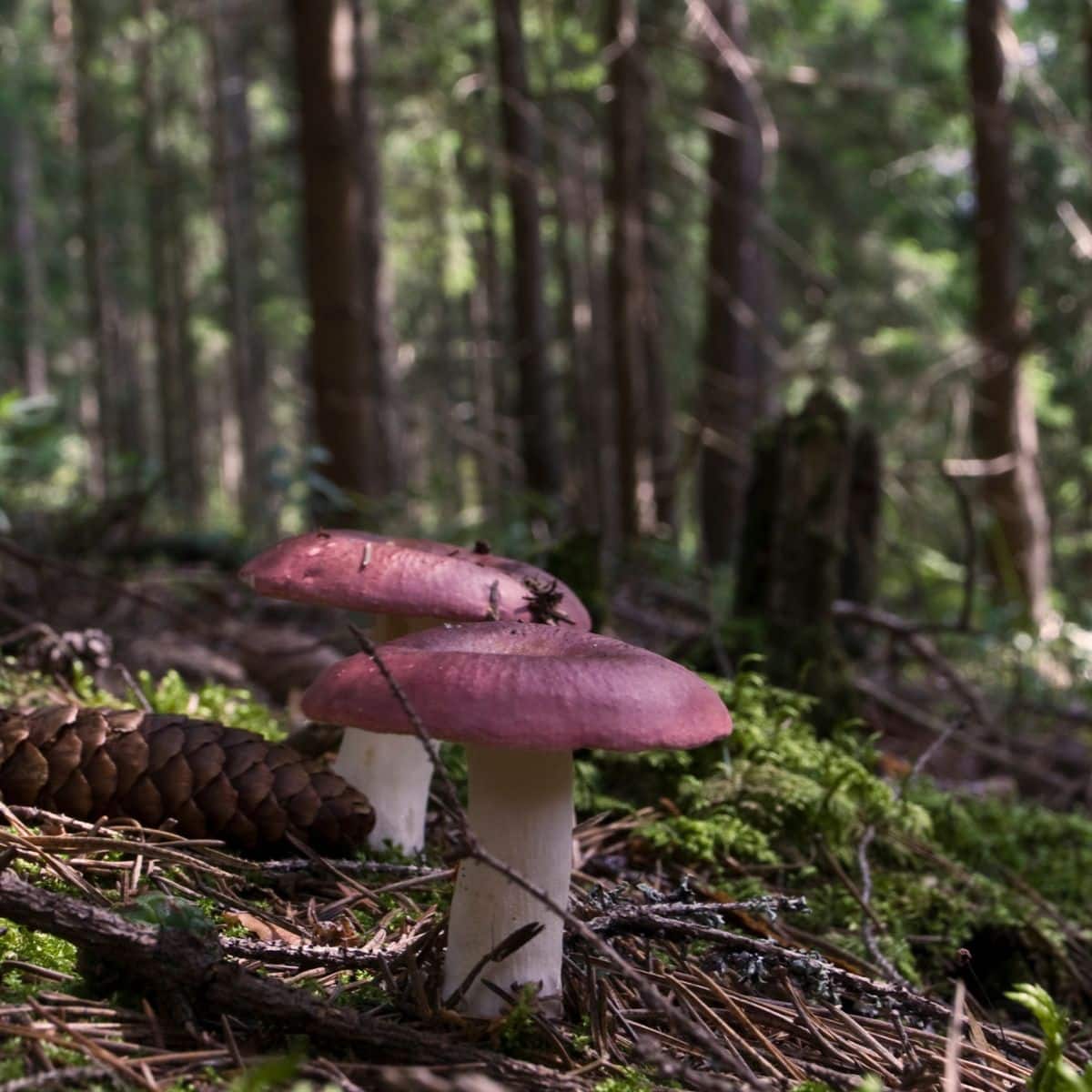

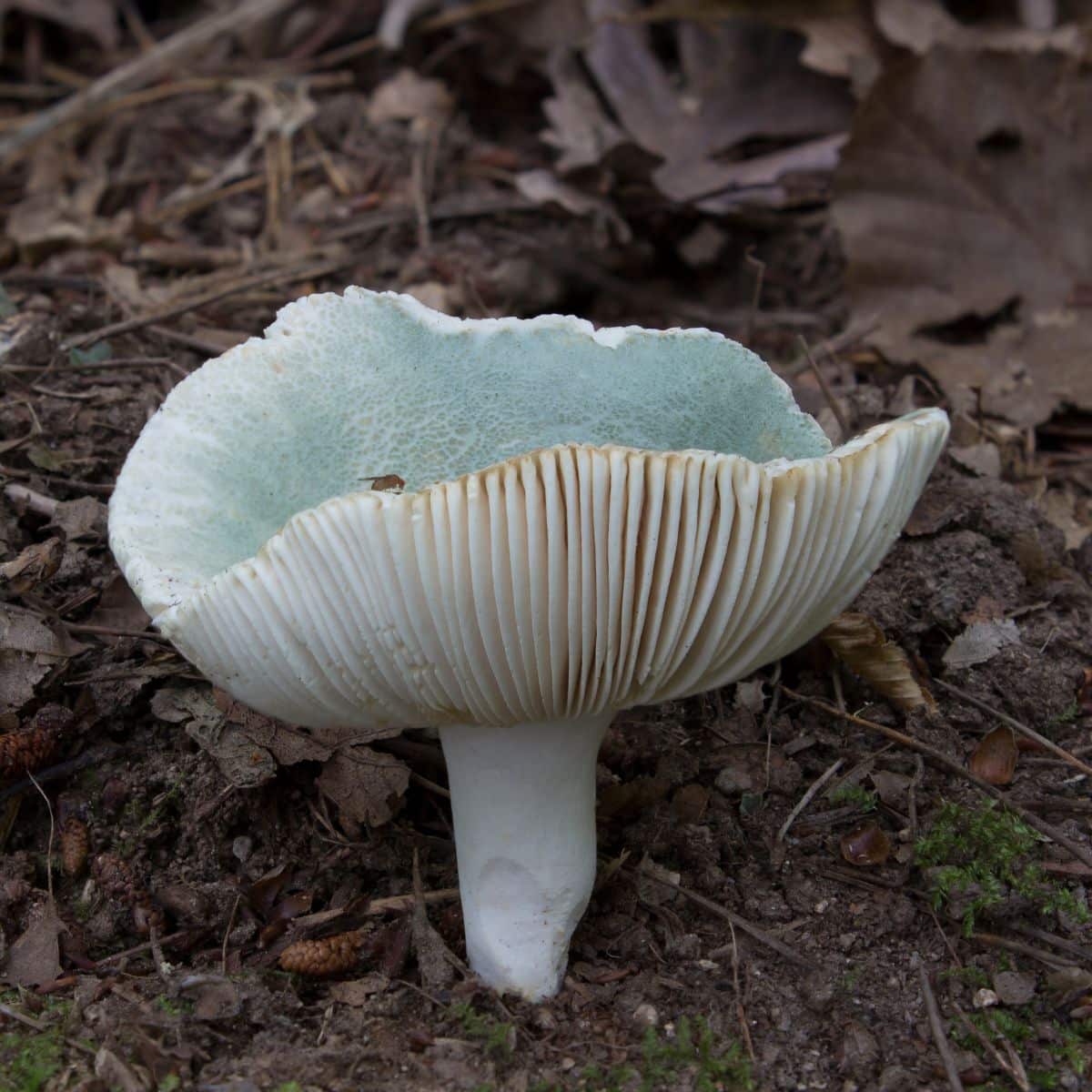
Toxic Russulas
There are a few species of Russula mushrooms to watch out for when foraging. These won’t kill you, but they’ll give you some very unpleasant gastrointestinal distress. The primary pattern between these toxic species is their acrid (spicy/peppery) taste. It may be that consumed specimens were not cooked thoroughly or adequately, and that caused the distress.
A good rule of thumb is always to do a nibble and spit taste test. Put a tiny piece of the mushroom on your tongue to check for taste, then spit it out. This is entirely safe to do with any Russula mushroom and is HIGHLY recommended.
The Sickener (Russula emetica)
This Russula must be mentioned before any discussion of foraging, as it is the one you have to look out for so you don’t accidentally collect it. There is debate as to whether this species occurs in North America – most experts don’t think so.
However, whether it occurs here or not, there is a lot of talk or passing down of information in mushroom circles that cautions to stay away from any red-capped Russula. While you certainly don’t want to eat this species or the Beech sickener described below, it may be unfair to red Russulas to have such a broad judgment. In some parts of the world, this mushroom is eaten after it is parboiled, which removes the toxins.
The sickener has a bright cherry-red or scarlet-red cap, which is not unusual in Russula mushrooms – there are over 100 red-capped Russulas in the world. Its gills are white or cream-colored and crowded, and the stem is white. This mushroom has a slightly fruity or spicy scent and tastes exceptionally peppery. A quick nibble and spit test quickly determines you do not want to eat this species. It grows with conifers, preferring spruces and pines.
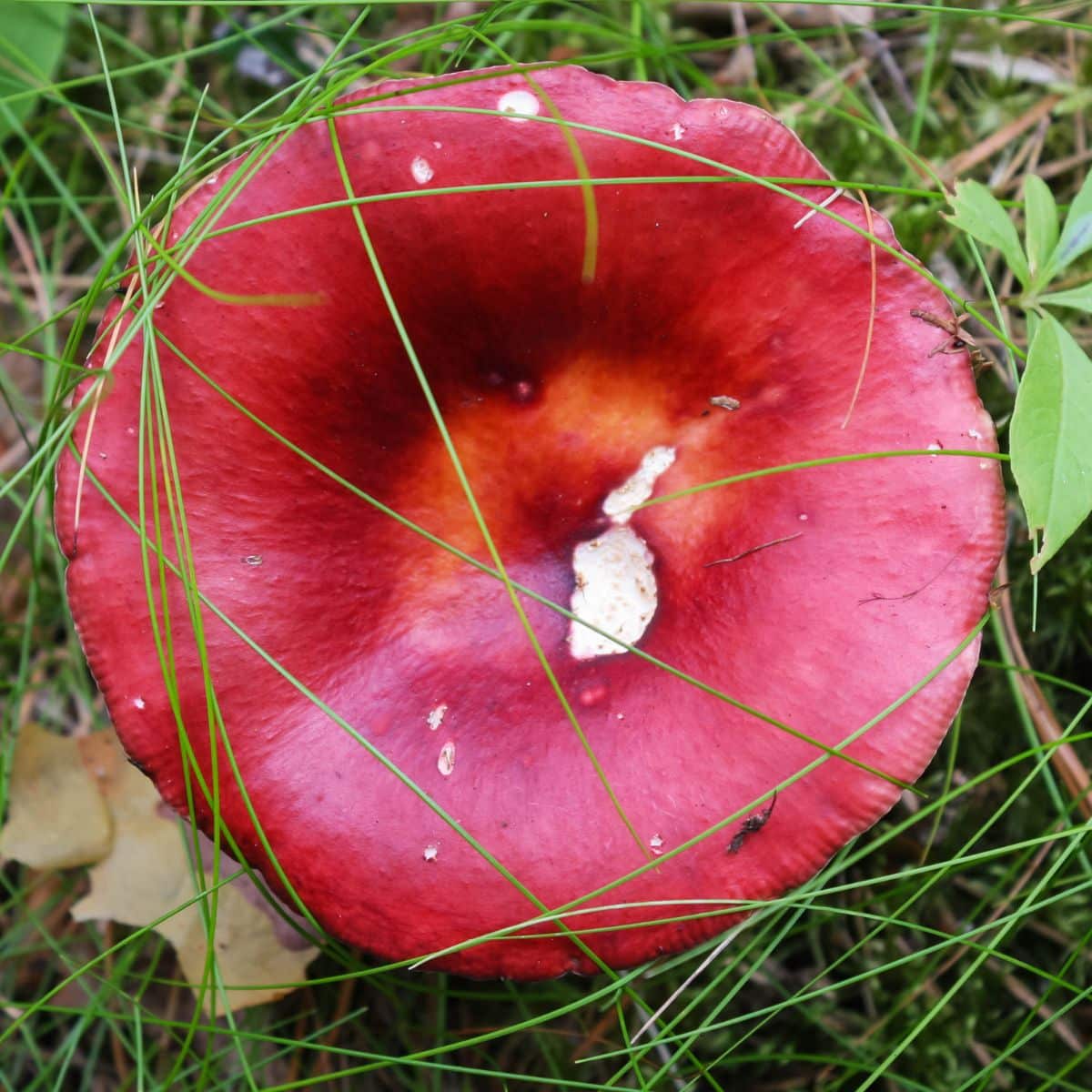
Beech Sickener (Russula nobilis)
This is another red-capped Russula species that will make you ill and which backs up the “beware of red-capped Russula” hypothesis. It is widespread across North America, associating with (surprise, surprise) beech trees. In addition to the red cap, the beech sickener has white gills and a white stem. The flesh is white or yellowish, smells a bit like coconut, and has an acrid, peppery taste.
The upside is that while this mushroom is toxic, it certainly won’t kill you. At most, it will cause some terrible gastrointestinal distress and possibly vomiting. And it will clear up after you’ve got it out of your digestive tract. That’s not fun by any means but hopefully alleviates some worry about accidentally eating it.

Foraging Russula Brittlegills
If you want to forage Russula mushrooms, go into the woods prepared. These mushrooms are fragile to the max; they’ll break apart with absolute ease and create a messy of mushroom bits in your bag or basket if you’re not careful. Even when you are super careful, they are very prone to breaking.
Bring a separate basket or bag specifically for Russulas to try to preserve them. And, make it a decent sized one. When these species are fruiting, it is often in great numbers.
It also can be quite the challenge to find these mushrooms without a boatload of bugs. Bugs and slugs LOVE these mushrooms. You can usually tell how infested the mushroom is by cutting the stem — you’ll see all the bug holes.
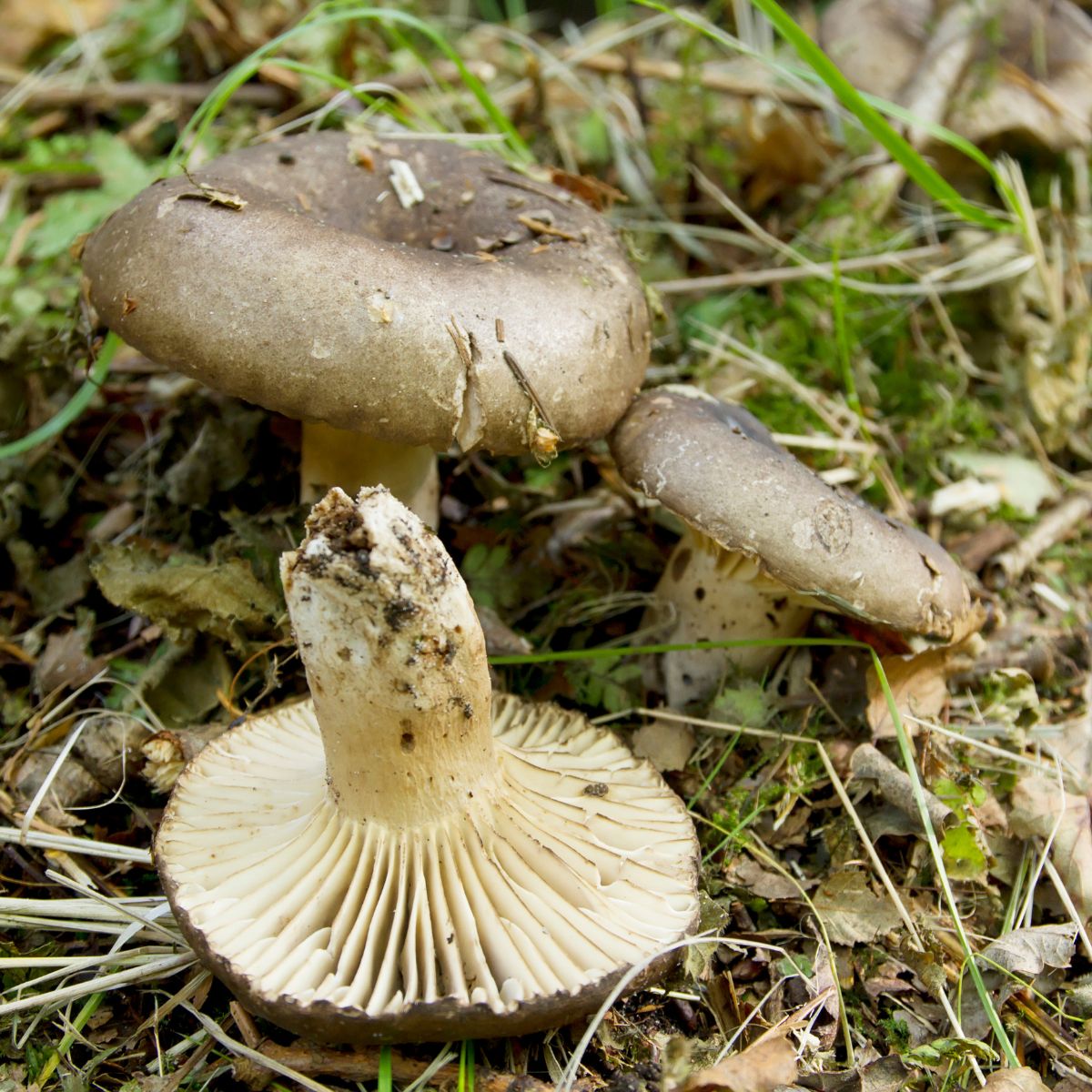
Top Russula Mushrooms in the United States: Species and Distribution
Russula mushrooms can be found throughout the United States, with various species occurring in different regions. Most North American mushroom guides advise caution when foraging these mushrooms due to their easy confusion in identification. But, in other countries, Russula species are favored and foraged in great quantity, even species that are found in North America, as well. Here is a selection of Russula species commonly found in the United States and that are less complicated to forage due to several defining characteristics:
Short-Stemmed Russula (Russula brevipes)
This all-white species is a somewhat decent edible in that you can eat it. It doesn’t have much flavor but is appreciated for its crisp texture and ability to take on the flavors of whatever it is cooked with.
The real draw to this mushroom, though, is what happens when it is parasitized by Hypomyces lactifluorum. This parasitization creates the much-adored and desired Lobster mushroom! So, even if you don’t want to eat the short-stemmed Russula on its own, mark where it grows, and maybe you’ll get lucky, and they’ll be parasitized.

Crab Brittlegill (Russula xerampelina)
As its name suggests, the crab brittlegill smells distinctly like boiled shellfish when it’s fresh. With maturity and when dried, the smell intensifies. It is an edible, mild-tasting species with a deep wine-colored or purple cap. The cap may also be greenish and is usually darker towards the center.
The gills of the crab brittlegill start out white but turn creamy yellow in color with maturity. The stem is whitish and sometimes has a red blush to it. When handled or cut, the stem, gills, and flesh all stain brown.

Yellow Swamp Brittlegill (Russula claroflava)
This Russula species grows with birch and aspen trees in wet places. It is a mild-tasting edible with a bright egg-yolk-colored cap and light white to tannish-yellow gills. The yellow swamp brittlegill smells fruity, and parts of the mushroom turn gray when bruised.

Charcoal Burner (Russula cyanoxantha)
This dark-capped species is edible with a mild, nutty taste. Its flesh isn’t as firm as other Russula species, but it still cooks up nicely. The charcoal burner has a greenish-brown or just green or just brown, or a combination, cap and a white stem. The gills don’t break as easily as other brittle gills and are instead flexible and slightly greasy to the touch.
This mushroom is commonly found in deciduous or mixed forests and has a preference for beech trees. It grows widespread across North America. The charcoal burner has a lookalike on the east coast which is also edible, Russula variata.

Quilted Green Brittlegills (Russula parvovirescens)
This species is among the easier to identify because it has a green cap with visible patches, or netting, across it. There are other Russula mushrooms that are green, but they don’t have the clear netting, they are solid colored. Quilted green brittlegills have a mild flavor. These grow widespread from Texas eastward.

Lookalikes and Similar Species
While Russula mushrooms have some distinctive characteristics, it is important to be aware of their lookalikes and similar species. Here are a few mushrooms that can be mistaken for Russula mushrooms:
Amanita species
Some Amanita mushrooms, such as Amanita muscaria and Amanita rubescens, share similarities in color and shape with certain Russula species. However, Amanita mushrooms have critical distinguishing features, such as a volva and a ring around the stem. Russula species never have a volva or a stem skirt.

Lactarius species
Lactarius mushrooms, also known as milk caps, can resemble Russula mushrooms due to their similar cap shape and gill attachment. However, Lactarius mushrooms exude a milky latex when their gills are damaged, a characteristic that differentiates them from Russula mushrooms.
Some Lactarius species only emit a small amount of milk, which isn’t that noticeable, especially when they’re past maturity or dried out. So, you have to be aware of that, too. Usually, though, you can see some evidence of milky latex or possible staining from it on the gills.
Indigo Milky Caps, Saffron Milky Caps, Candy Caps, and Weeping Milkcaps are a few of the top edible Lactarius mushrooms.

Edibility and Culinary Uses
Edible Russula species can be prepared in various culinary dishes. They can be sautéed, grilled, incorporated into soups, stews, pasta dishes, or pickled for extended use. However, it is essential to cook Russula mushrooms thoroughly to ensure their edibility.
Russula mushroom recipes:

If you would like to read more about the complexity of Russula species, you must check out Michael Kuo’s detailed, intensive, and very amusing take on the whole genus. If you’re in the Pacific Northwest, Benjamin Woo’s exhaustive, informative, and entertaining documentation of the Russula species there is a must read.
Common Questions About Russula Mushrooms
Are Russula mushrooms medicinal?
While Russula mushrooms are primarily appreciated for their culinary value, some species have been studied for their potential medicinal properties. Research suggests that certain compounds found in Russula mushrooms may possess antioxidant, anti-inflammatory, and immunomodulatory effects. However, further scientific investigation is needed to fully understand their therapeutic potential and possible applications.
Are any Russula mushrooms poisonous?
There are no deadly poisonous members in North America. One species member, though, (Russula subnigricans) found in China, Japan, is listed as deadly.








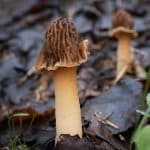
Leave a Reply